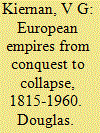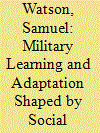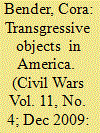| Srl | Item |
| 1 |
ID:
163924


|
|
|
| 2 |
ID:
038329


|
|
|
|
|
| Publication |
Douglas, Fontana paperbacks, 1982.
|
| Description |
285p.Pbk
|
|
|
|
|
|
|
|
|
|
|
|
Copies: C:1/I:0,R:0,Q:0
Circulation
| Accession# | Call# | Current Location | Status | Policy | Location |
| 028029 | 940.28/KIE 028029 | Main | On Shelf | General | |
|
|
|
|
| 3 |
ID:
159438


|
|
|
|
|
| Summary/Abstract |
The regular army, rather than citizen-soldiers, drove nineteenth-century U.S. military history (apart from the Civil War). The national standing army was crucial to the defeat of Native Americans, and more important than citizen-soldiers or white pressure on Native American subsistence. Despite new circumstances west of the Mississippi River, the contexts and methods of this warfare did not fundamentally change, and learning (or relearning) and adaptation were crucial to the army’s success. The most important learning was strategic, particularly in lessons of patience, persistence, and control over the initiation and conduct of warfare, and responded to external, non-military contexts (the tug of war between citizen land hunger and tax aversion). Army learning and adaptation did not win these wars by itself, but it facilitated the effective and successful use of force at a cost the nation was willing to pay, and reduced the incidence of large-scale atrocity in comparison with operations by citizen-soldiers.
|
|
|
|
|
|
|
|
|
|
|
|
|
|
|
|
| 4 |
ID:
103129


|
|
|
|
|
| Publication |
2009.
|
| Summary/Abstract |
Based on my own earlier theorising of 'mimesis at war', and taking up Simon Harrison's suggestion that trophies made from human body parts are best explained as 'transgressive objects', the article focuses on a particular trophy, a nineteenth century Cheyenne finger necklace. Its history illustrates that trophy-taking was part of a broader circulation of practices of war among native warriors and the American military in the West. Finally, trophy-taking made its way into the academic and scientific institutions that provide the discursive frame for present debates about war in anthropology and archaeology.
|
|
|
|
|
|
|
|
|
|
|
|
|
|
|
|